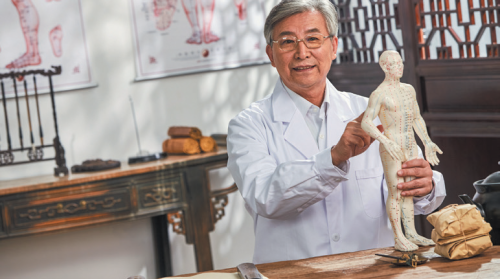For 3,000 years, acupuncture has been a staple of Chinese health care, where it is regularly used to treat conditions as diverse as insomnia, pain, and the symptoms of menopause.
In the United States, the history of the practice is shorter—the first legal acupuncture center opened in 1972—but acupuncture is now the most widely used alternative medical practice in the nation.
It’s supported by an impressive body of research, offered by some of the most respected academic medical institutions, including the Mayo Clinic and Harvard Medical School, and covered by several major insurers. Even the U.S. Army endorses it as a treatment for chronic pain.
Theory of acupuncture
In acupuncture, thin, sterile needles are gently inserted through the skin at different points in the torso, limbs, and head. These points are positioned along a network of pathways called meridians that are dotted with acupuncture points, also called acupoints.
Traditional Chinese medicine practitioners believe that organs, tissues, muscles, and ligaments are all connected, and that meridians run the length of the body, so the needle placement is often unexpected. For example, chronic headaches may be treated with needles on the hands and ankles as well as the head. Upper back and shoulder pain, for instance, is associated with a blockage in the bladder meridian, which has 67 acupoints starting at the eye, crossing the forehead, running down the back of the head, past the buttocks, and ending at the pinky toes.
When an acupuncturist stimulates acupoints with needles, it signals the brain and body to produce endogenous opioids, powerful pain-relieving chemicals, anti-inflammatory compounds, immune-boosting compounds, hormones, and vasodilators that increase blood circulation. Traditional acupuncturists also believe that stimulating acupoints releases blockages in the body’s flow of energy, called qi (pronounced chee). For many people, that stimulation translates to pain relief.
Proven pain relief
In a report published in the National Institute for Health Research Journals Library, researchers reviewed 29 clinical trials and concluded that adding acupuncture to standard medical care (anti-inflammatory medications and physical therapy) reduced the severity of neck and lower back pain, significantly reduced the number of headaches and migraines, and eased the pain and disability of osteoarthritis. The American College of Physicians recommends acupuncture and other non-pharmacologic therapies as first-line treatments for patients experiencing chronic low-back pain. I
t’s even used for pain relief in veterinary medicine. Studies show it can ease chronic spinal and osteoarthritic pain, as well as acute pain from neuromusculoskeletal injuries and surgery. Since animals don’t have expectations for a treatment to work, veterinary applications offer exciting evidence that acupuncture offers more than a placebo effect.
Alzheimer’s disease
In a 2019 review article published in Frontiers in Psychiatry, researchers reported that acupuncture may be beneficial for people with Alzheimer’s disease. They cite multiple small studies that have found that acupuncture can improve mood and cognition and increase verbal and motor skills. A clinical trial with 87 patients found that acupuncture improved cognitive function better than the medication donepezil (Aricept), with benefits that lasted for 12 weeks.
Hot flashes
Acupuncture also appears to ease hot flashes from breast cancer treatment and menopause. In a Journal of Clinical Oncology study of breast cancer patients experiencing treatment-related hot flashes, those who received weekly acupuncture as part of a three-month self-care regimen including exercise, nutrition, and psychological support had hot flash scores (calculated as the frequency of hot flashes multiplied by the average severity) that were 50 percent lower than those in the acupuncture-free self-care protocol. Importantly, the benefits continued for six months after the acupuncture ended.
In another study, women who underwent five weeks of acupuncture had fewer hot flashes, less frequent and less severe night sweats, and fewer sleep, skin, and hair problems than women in the control group.
Acupuncture may provide these benefits by dilating blood vessels, similar to what hormone replacement therapy does, and triggering the release of endorphins (stress- and pain-relieving chemicals) and hormones related to mood regulation.
Fight insomnia and depression
After reviewing 46 clinical trials, researchers reported in the peer-reviewed Journal of Alternative and Complementary Medicine that acupuncture independently improves sleep quality and duration and amplifies the benefits of other insomnia interventions. Last year, a different team reported that eight weeks of electroacupuncture (acupuncture with mild electrical stimulation) improved the quality and quantity of people’s sleep, and significantly improved depression symptoms.
Depression and anxiety
Many studies have reported that acupuncture can ease depression. At least one has found that it may be more effective than medication. Similarly, studies show that it can treat both general and preoperative anxiety. The quality of these studies, however, tends to be low—but so are the risks as long as you visit a certified acupuncture practitioner who uses sterile or single-use needles. (To find an acupuncturist, visit NCCAOM.org.)
What to expect
For many people, the largest barrier to trying acupuncture is a fear of needles, but the most you should feel is a small pinch, if anything at all. Once the needle is in, you may have a mild awareness that something is there, but you won’t experience pain.
On average, sessions last about 25 minutes. Many acupuncturists will treat acute issues twice a week and chronic conditions once a week, continuing until the problem is resolved or you’ve hit a plateau in improvement. In general, newer health problems resolve more quickly than chronic issues.
Acupuncture tends to have very few side effects, although some people may experience minor bleeding or soreness at the insertion sites. It can lower blood pressure and blood sugar levels, depending on which acupoints are stimulated, so be sure to hydrate and eat before your session.

